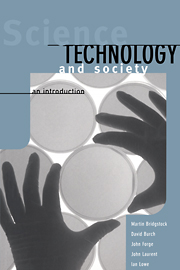Book contents
- Frontmatter
- Contents
- List of Figures
- List of Tables
- List of Contributors
- Preface
- Part One Scientific and Technological Communities
- Part Two Scientists and Technologists in the Wider Society
- 6 The Industrial Revolution in Great Britain
- 7 Science, Technology and the Economy
- 8 Science, Technology and Economic Theory
- 9 Science, Technology and Public Policy
- 10 Science, Technology and the Less-developed Countries
- 11 Science, Technology and the Future
- Appendix 1 Surviving in the Information Jungle
- Appendix 2 Referencing
- Index
9 - Science, Technology and Public Policy
Published online by Cambridge University Press: 04 February 2010
- Frontmatter
- Contents
- List of Figures
- List of Tables
- List of Contributors
- Preface
- Part One Scientific and Technological Communities
- Part Two Scientists and Technologists in the Wider Society
- 6 The Industrial Revolution in Great Britain
- 7 Science, Technology and the Economy
- 8 Science, Technology and Economic Theory
- 9 Science, Technology and Public Policy
- 10 Science, Technology and the Less-developed Countries
- 11 Science, Technology and the Future
- Appendix 1 Surviving in the Information Jungle
- Appendix 2 Referencing
- Index
Summary
This chapter begins by explaining why governments take an interest in science and technology. Some of the problems of determining the collective will of the community are then analysed, showing that it is often difficult to decide priorities for allocation of public resources. This leads into a general discussion of what constitutes public policy, including the process of policy development. Science and technology policy raises particular issues which are especially important for professional scientists and engineers, but are also of broad public interest. These issues are considered in general terms before the chapter concludes with a discussion of some specific problems affecting Australia and New Zealand in the 1990s. These problems illustrate once more that the way we treat science and technology affects what is produced.
Why public policy for science and technology?
Public policy for science is necessary because a significant fraction of all science is funded by government, so decisions must be made about the scale and direction of that funding. We are talking about large sums of money. In Australia in 1996 government spending on science and technology was running at about $4 billion per year, so on average each person in the community was supporting science with about $200 per year through taxes. Because choices about which technologies will be used and how they are used have significant social impact, governments intervene to try to keep those impacts acceptable to the community.
- Type
- Chapter
- Information
- Science, Technology and SocietyAn Introduction, pp. 181 - 205Publisher: Cambridge University PressPrint publication year: 1998



